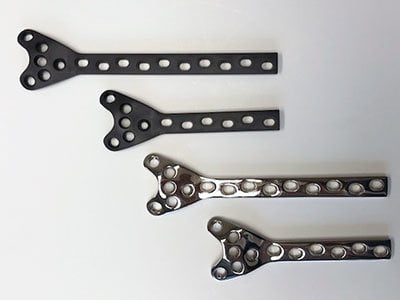Home - Medical Grade Plastics Applications - Advantages of Carbon-fiber PEEK in Trauma Fixation Devices
How can PEEK polymers assist with trauma fixation?
The Centers for Disease Control (CDC) define trauma as any wound or injury resulting from the application of force or violence to a living body. Under that definition, medical professionals face an exhaustive range of complications. Among the most common are bone fractures or conditions that attack bone tissue, such as tumors. Trauma fixation devices are an essential, frontline treatment for bone fractures and tissue degeneration, and are among the oldest devices still in modern use. Although these devices have been in use for many decades, trauma fixation devices are constantly being iterated. Perhaps the most promising avenue of development is enhancing device engineering using high-performance plastics.

Trauma fixation refers to a number of treatment approaches, but usually concerns bone fractures. As bone must be stabilized to heal properly, hardware implantation is a standard method of treatment. This can come in the form of external or internal fixation.
- CF PEEK bone plates offer improved fatigue strength – CF reinforced PEEK polymers can increase the fatigue life of the implanted device compared to metal/stainless steel-based plates.
- CF PEEK provides complete radiolucency – Metal plates do not provide for unobscured imaging for the surgeon and this can restrict the surgeon’s ability to see exactly what is occurring intra-operatively. Furthermore, the use of CF PEEK bone plates allows for the clearest and unobstructed post-operative visualization for follow up visits to evaluate healing.
- Well-matched modulus to bone using CF PEEK – Bone healing is improved by using the CF PEEK polymer rather than metal/stainless steel due to its stiffness being more similar to bone than metals. Earlier healing can lead to better overall patient outcomes.
- Easier revisions with CF PEEK – If the removal of an implant is required, the CF PEEK plate can be removed easier than a metal plate due to less bone on-growth onto the implanted device. This ease of removal can result in reduced surgical times and costs.
Future advancements in PEEK implants will potentially feature antimicrobial properties, reducing the likelihood of infection around the implantation site. Even without those advancements, though, PEEK is increasingly becoming the material of preference in trauma fixation devices.
Beyond bone plates and screws, PEEK and PAEK polymers are used for applications relating to facial trauma. Craniomaxillofacial, or CMF, implants are essential for facial trauma or tumor resection, and are increasingly fabricated from PAEK or PEEK polymers for numerous reasons:
- PEEK and PAEK CMF devices can be rapidly fabricated – As PEEK and PAEK are easily machinable, and can be machined into any shape, they can be fabricated into patient-specific implants. Though this is possible with titanium and cobalt chrome devices, it’s more expensive and more labor intensive, resulting in extended lead times.
- PEEK and PAEK CMF devices are more comfortable – As PEEK and PAEK implants are derived from polymers, they are much lighter than metal alternatives, so patients adapt to their presence faster. Further, PEEK and PAEK offer much lower thermal conductivity, so they are less sensitive to changing temperatures.
